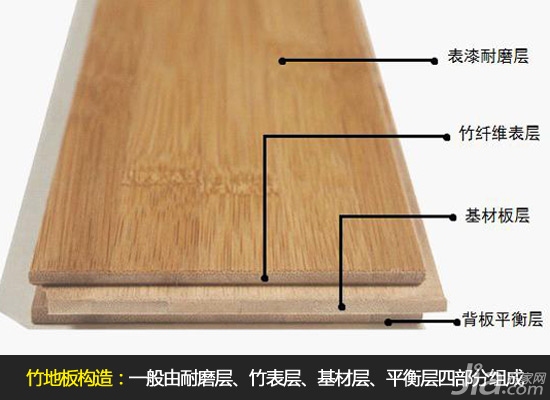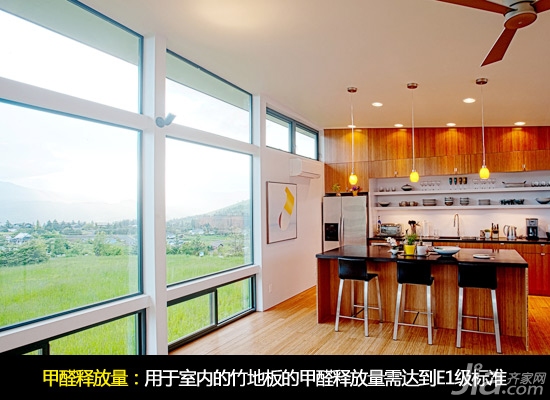Bamboo floor shopping guide

Wenya bamboo room bamboo flooring classification and introduction
China's bamboo grows mainly in the area south of the Yangtze River basin. It is rich in resources. Due to its special high hardness and warmth, bamboo is often superior to the same-price wood flooring in terms of cost performance. With the natural unique texture of bamboo flooring, it seems that there is a refreshing effect that returns to nature after paving. In recent years, it has gradually become a popular item in the furniture market. Let's take a look at the construction and classification of bamboo flooring.
1, the structure of bamboo flooring

The bamboo flooring consists of four main parts. The top layer is a wear-resistant layer of aluminum oxide, which mainly protects the surface of bamboo. The second layer is the surface layer of bamboo flooring. It is pressed with the original bamboo to retain the original bamboo texture. The third layer of substrate The layer is generally made of bamboo or wood to break the high pressure and low carbon environmental protection; the bottom layer is the backplane balance layer, which can effectively prevent the deformation of the floor and avoid the corrosion of the cement tide.
2, the classification of bamboo flooring
Bamboo flooring is classified according to structure: it can be divided into real bamboo flooring, real bamboo flooring, solid bamboo flooring, bamboo flooring, heavy bamboo flooring, and so on. Flat pressure and side pressure differ depending on the selected bamboo section, and the texture will vary.
Bamboo flooring is classified according to processing methods: it can be divided into natural bamboo flooring and carbonized bamboo flooring. The natural bamboo flooring maintains the original color of the bamboo material, and the bamboo strips of the carbonized bamboo flooring are subjected to a high temperature and high pressure carbonization process, so that the color of the bamboo pieces is deepened, and the color of the bamboo pieces is uniform.
3, analysis of advantages and disadvantages of bamboo flooring
Advantage
Since it is warm in winter and cool in summer, bamboo has a low thermal conductivity and does not produce cold and heat. Particularly suitable for paving in the living room, bedroom, gym, study room, studio, hotel and other ground and wall decoration; solid and wear-resistant texture, soft and beautiful color, bamboo fresh and natural, pleasant bamboo; cost-effective, the price is Composite floor and solid wood floor, the effect is very natural, maintenance is relatively simple;
Disadvantage
Insufficient stability, bamboo flooring contraction and expansion than solid wood flooring; affected by the sun and moisture prone to delamination phenomenon; some bamboo flooring is easy to grow worms, affecting the life of the floor;
Second, understand the material standard to buy high-quality bamboo flooring
Bamboo flooring is a kind of environmentally friendly plate made of natural bamboo and processed through advanced processes. When selecting bamboo flooring, we can first understand its material standards, and then make appropriate purchases according to the actual conditions of home decoration.
Standard one: common size of bamboo flooring
The bamboo flooring on the market has long specifications. The general dimensions of bamboo flooring are mainly 15*90*909mm, 15*96*960mm, 15*96*1850mm/1920mm, and 15*190*1900mm. When buying, you can't blindly pursue large-size, large-size bamboo flooring. In general, the smaller the floor size, the better the resistance to deformation.
Standard II: moisture content of bamboo flooring
The moisture content affects the service life of bamboo flooring. In general, the moisture content should be controlled within 8%. However, due to the different humidity in different places, there are certain differences in the selection of the moisture content of bamboo flooring, and attention must be paid to the adaptability of the moisture content to the local area. There are many untreated and crude bamboo flooring on the market. It is easily affected by moisture and moisture. After installation for a period of time, the floor is dark, loses luster and shrinks. It should be carefully identified when purchasing.
Standard 3: Wear resistance of bamboo flooring
Bamboo floor wear-resistant rotation of 550 turns is a qualified product. The main factor that determines the level of wear resistance is the amount of wear-resistant primer. Most of the bamboo floors are not as durable as the 6,000-ton laminate flooring, but they are still better than solid wood flooring.
Standard 4: formaldehyde emission from bamboo flooring

As with wooden flooring, the most important thing to buy bamboo flooring is whether its formaldehyde emission indicators are qualified. The formaldehyde emission limit of the national standard E1 product is less than 1.5mg/L, which is an indicator we must understand before purchasing.
Third, to avoid misunderstanding analysis of bamboo flooring error analysis
Because bamboo flooring is a new type of material flooring, many consumers often have inadequate knowledge of it. In order to avoid everyone entering the bamboo floor shopping mistakes, here are some common misunderstandings.
Misunderstanding 1: Think bamboo flooring bamboo as long as possible
The age of bamboo is not older and more solid. The 9-year old bamboo is too thick to make the floor more brittle. Bamboo under 4 years of age is too bamboo, and the stability of bamboo is usually optimal from 4 to 6 years.
Misunderstanding 2: The longer and thicker the bamboo flooring, the better
The wider the floor, the more vulnerable to cracking warpage, the proposed bamboo flooring width should not exceed 130 mm. In terms of thickness, the bamboo material itself has a very high hardness, and 15 mm thick has sufficient bending resistance, compression resistance, impact resistance, and good foot feel. Some manufacturers to cater to consumers, the thicker the better the state of mind, do not go green, do not go yellow, bamboo glued, although the thickness of bamboo flooring up to 17mm, 18mm, but the bonding strength is not good, easy to crack, this approach It is unscientific.
Misunderstanding 3: Excessive pursuit of uniform color on the surface texture
Because bamboo has a smaller radius than wood and is less exposed to sunlight, there is a significant difference in color. When selecting bamboo flooring, it is not necessary to pursue the consistency of texture, allowing slight color difference, and the overall uniformity is good.
Myth 4: Bamboo flooring is easy to infest and moldy
Bamboo is rich in nutrients such as sugar, starch, amino acids and proteins, and it easily attracts insects and mildew. Bamboo flooring has been fully considered this characteristic of bamboo. Bamboo flooring is a product made by high temperature treatment. Unlike ordinary bamboo, it is not prone to bugs, mildew, etc.
Myth 5: Bamboo flooring sold and laid apart
If the seller and the laying party are not the same unit, it will easily lead to problems in the floor and push each other, causing consumers to suffer. Therefore, it is best to choose bamboo flooring manufacturers who provide laying services.
Bamboo Flooring Waxing Floor Maintenance Formaldehyde Door Price Home Decoration Paint Cement Decor Living Room Study Furniture Small Study Small Bedroom
Coal Activated Carbon For Recycling Of Solvents
Using high quality coal as raw material for solvent recovery, coal is mainly used in the recovery of benzene, toluene, ether, alcohols, gasoline, three, methyl chloride, organic solvents and other hydrocarbons, as well as the vapor recovery of hydrocarbon compounds.
Use: Used in the seperation and recycling of aethers, ketons, alcohols, tetrahydrofuran, methylene dichloride, trichloromethane, trichloroethylene, chlorinated polyvinyl chloride, carbon bisulfide, benzene, gasoline etc.
Spec.:
|
Model NO.
|
Moisture(%)
|
Strength(%)
|
Ash(%)
|
carbon tetrachloride(%)
|
Benzene absorption(%)
|
Packing density (g/L)
|
Ignition point(°C)
|
Grain diameter(mm)
|
| ZH-2080 |
≤3
|
≥93
|
≤12
|
≥80
|
≥44
|
470±20
|
≥350
|
Φ2.0
|
| ZH-2090 |
≤3
|
≥90
|
≤12
|
≥90
|
≥50
|
440±20
|
≥350
|
Φ2.0
|
| ZH-20100 |
≤3
|
≥90
|
≤14
|
≥100
|
≥55
|
370±20
|
≥350
|
Φ2.0
|
| ZH-3080 |
≤3
|
≥93
|
≤12
|
≥80
|
≥44
|
460±20
|
≥350
|
Φ3.0
|
| ZH-3090 |
≤3
|
≥90
|
≤12
|
≥90
|
≥50
|
450±20
|
≥350
|
Φ3.0
|
| ZH-30100 |
≤3
|
≥90
|
≤14
|
≥1000
|
≥55
|
400±20
|
≥350
|
Φ3.0
|
| ZH-4080 |
≤3
|
≥95
|
≤10
|
≥80
|
≥44
|
450±20
|
≥350
|
Φ4.0
|
| ZH-4090 |
≤3
|
≥93
|
≤12
|
≥90
|
≥50
|
420±20
|
≥350
|
Φ4.0
|
| ZH-40100 |
≤3
|
≥90
|
≤14
|
≥100
|
≥55
|
370±20
|
≥350
|
Φ4.0
|
| ZH-5070 |
≤3
|
≥90
|
≤10
|
≥70
|
≥38
|
460±20
|
≥350
|
Φ5.0
|
| ZH-6070 |
≤3
|
≥90
|
≤10
|
≥70
|
≥38
|
450±20
|
≥350
|
Φ6.0
|
| ZH-7070 |
≤3
|
≥90
|
≤10
|
≥70
|
≥38
|
440±20
|
≥350
|
Φ7.0
|
Coal Activated Carbon For Recycling Of Solvents
Coal Activated Carbon For Recycling Of Solvents,Activated Charcoal,Coal Based Activate Carbon,Coal Bulk Activated Carbon
SHIZUISHAN ZhongShi activated carbon co,.ltd , https://www.zscarbonchina.com